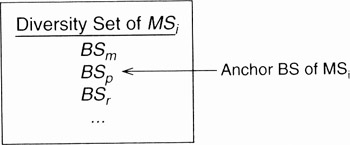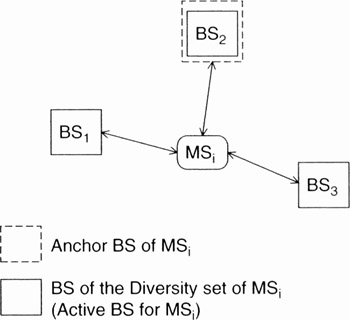14.4 Fast BS Switching (FBSS) and Macro Diversity Handover (MDHO)
14.4 Fast BS Switching (FBSS) and Macro Diversity Handover (MDHO)
14.4.1 Diversity Set
There are several conditions that are required to the diversity BSs featured in FBSS and MDHO procedures. These conditions are listed below [2]:
-
The BSs are synchronised based on a common time source and have synchronised frames.
-
The frames sent by the BSs from the diversity set arrive at the MS within the prefix interval, i.e. transmission delay <cyclic prefix.
-
The BSs operate at same frequency channel.
-
The BSs are required to share or transfer MAC context. Such context includes all information MS and BS normally exchange during Network Entry, particularly the authentication state, so that an MS authenticated/registered with one of the BSs from the diversity set BSs is automatically authenticated/registered with other BSs from the same diversity set. The context also includes a set of service flows and corresponding mapping to connections associated with the MS, current authentication and encryption keys associated with the connections. There are also BS conditions specific to MDHO (see below).
An MS may scan the neighbour BSs and then select BSs that are suitable to be included in the diversity set. The MS reports the selected BSs and the diversity set update procedure is performed by the BS and the MS. After an MS or BS has initiated a diversity set update using MOB_MSHO/BSHO-REQ, the MS may cancel the diversity set update at any time. This cancellation is made through transmission of an MOB_HO-IND with proper parameters. The BS may reconfigure the diversity set list and retransmit the MOB_BSHO-RSP message to the MS.
In an MS diversity set, a member identifier, TEMP_BSID, is assigned to each BS in the diversity set.
14.4.2 Different Types of BS for a Given MS
Before getting into the details of make-before-break handover algorithms, FBSS and MDHO, the different types of BS for a given MS are summarized:
-
Serving BS. The serving BS is the BS with which the MS has most recently completed registration at the initial Network Entry or during a handover.
-
Neighbour BS. A neighbour BS is a BS (other than the serving BS) whose downlink transmission can be (relatively well) received by the MS.
-
Target BS. This is the BS that an MS intends to be registered with at the end of a handover.
-
Active BS. An active BS is informed of the MS capabilities, security parameters, service flows and full MAC context information. For a Macro Diversity HandOver (MDHO), the MS transmits/receives data to/from all active BSs in the diversity set.
-
Anchor BS. For MDHO or FBSS supporting MSs, this is a BS where the MS is registered, synchronised, performs ranging and monitors the downlink for control information (see Figure 14.3). For an FBSS supporting MS, this is the serving BS that is designated to transmit/receive data to/from the MS at a given frame. Hence, it can be verified that an anchor BS is a specific case of a serving BS. An MS is required continuously to monitor the signal strength of the BSs that are included in the diversity set. The MS selects one BS from its current diversity set to be the anchor BS and reports the selected anchor BS on the CQICH (see Chapter 9) or MOB_MSHO-REQ message. The MSs and BSs may use the fast-feedback method to update the diversity set: when the MS has more than one BS in its diversity set, the MS transmits fast anchor BS selection information to the current anchor BS using the OFDMA fast-feedback channel (see the OFDMA frame in Chapter 9).

Figure 14.3: Illustration of an anchor BS in a diversity set
14.4.3 FBSS (Fast BS Switching)
An FBSS handover begins with a decision for an MS to receive/transmit data from/to the anchor BS that may change within the diversity set. An FBSS handover can be triggered by either MOB_MSHO-REQ or MOB_BSHO-REQ messages [2].
When operating in FBSS, the MS only communicates with the anchor BS for uplink and downlink messages (management and traffic connections). The MS and BS maintain a list of BSs that are involved in FBSS with the MS. This is the FBSS diversity set. The MS scans the neighbour BSs and selects those that are suitable to be included in the diversity set. Among the BSs in the diversity set, an anchor BS is defined. An FBSS handover is a decision by an MS to receive or transmit data from a new anchor BS within the diversity set.
The MS continuously monitors the signal strength of the BSs of the diversity set and selects one of these BSs to be the anchor BS. Transition from one anchor BS to another, i.e. BS switching, is performed without exchange of explicit handover signalling messages. An important requirement of FBSS is that the data are simultaneously transmitted to all members of a diversity set of BSs that are able to serve the MS.
The FBSS supporting BSs broadcast the DCD message including the H_Add Threshold and H_Delete Threshold. These thresholds may be used by the FBSS-capable MS to determine if MOB_MSHO-REQ should be sent to request switching to another anchor BS or changing diversity set.
14.4.4 MDHO (Macro Diversity Handover)
An MDHO begins with a decision for an MS to transmit to and receive from multiple BSs at the same time. An MDHO can start with either MOB_MSHO-REQ or MOB_BSHO-REQ messages. When operating in an MDHO, the MS communicates with all BSs in the diversity set for uplink and downlink unicast traffic messages (see Figure 14.4). The use of this transmission diversity is not the same in the two different communications:
-
For a downlink MDHO two or more BSs provide synchronised transmission of MS downlink data such that diversity combining can be performed by the MS.
-
For an uplink MDHO, the transmission from an MS is received by multiple BSs such that selection diversity of the information received by multiple BSs can be performed.

Figure 14.4: Illustration of an MDHO operation mode
The BSs involved in an MDHO or equivalently a member of an MS MDHO diversity set must use the same set of CIDs for the connections that have been established with the MS. The same MAC/PHY PDUs should be sent by all the BSs involved in the MDHO to the MS.
The decision to update the diversity set and the process of anchor BS update begin with notifications by the MS (through the MOB_MSHOREQ message) or by the BS (through the MOB_BSHO-REQ message).
EAN: 2147483647
Pages: 124